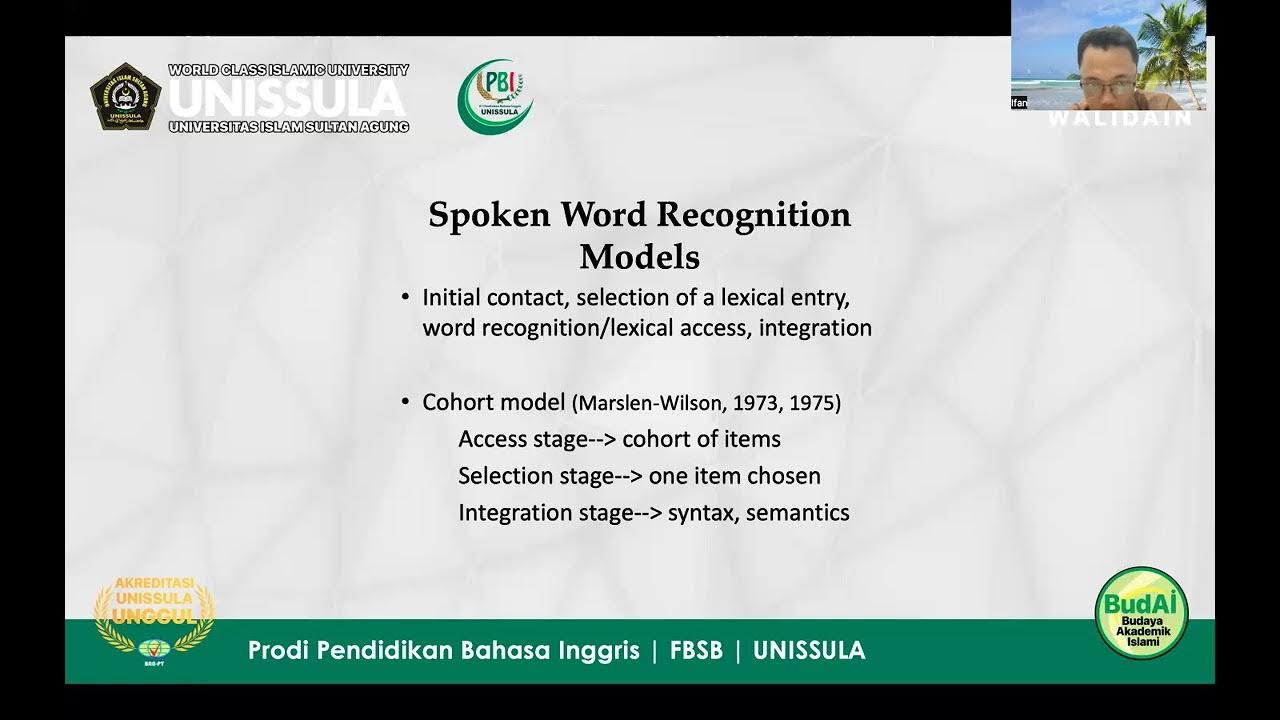Introduction to Second Language Acquisition
Summary
TLDRThis video script delves into second language acquisition (SLA), contrasting it with first language learning. It explains the concepts of L1 and L2, the natural and formal learning processes, and the roles of innate capacity and social experience. The script also touches on different types of language learning, such as informal, formal, and mixed settings, and discusses the challenges and phenomena associated with SLA, including positive and negative transfer, ultimately aiming to provide insights into how languages are acquired beyond childhood.
Takeaways
- 🌟 The distinction between L1 (first language) and L2 (second language) is based on the order of acquisition, with L1 being acquired naturally from early childhood and L2 requiring more conscious effort.
- 📚 Second Language Acquisition (SLA) is the study of individuals learning a language subsequent to their first language and encompasses both formal and informal learning settings.
- 🏫 Formal L2 learning occurs in classrooms, while informal L2 learning happens through naturalistic contexts, such as immersion in a foreign environment.
- 🌐 The term 'second language' is used regardless of how many languages one learns after the first, including third, fourth, or subsequent languages.
- 🎯 The target language (TL) is the language that learners aim to acquire, whether it's for education, employment, or other purposes.
- 🌱 Simultaneous multilingualism refers to the acquisition of more than one language during early childhood, while sequential multilingualism involves learning additional languages after L1 is established.
- 🌐 Multilingualism is the ability to use two or more languages, and it's often used interchangeably with bilingualism, which specifically refers to two languages.
- 👶 Innate capacity for language learning is genetically given to every human child, allowing them to master the complexity of language without conscious effort.
- 🔄 Positive transfer in L2 learning occurs when an L1 structure or rule is correctly applied in the L2, while negative transfer happens when it leads to errors.
- 📈 The development of L1 and L2 is systematic and includes predictable sequences, but L2 learners may not reach the same level of native-like competence due to various factors.
- 📝 The final state of L2 learning may include instances of L1 interference or creative structures, indicating that not all learners achieve full native-like proficiency.
Q & A
What is the difference between a first language (L1) and a second language (L2)?
-A first language (L1) is the language an individual learns from a very young age without much conscious effort. A second language (L2) is any language learned after the first language and typically requires more deliberate effort in learning.
What is meant by 'second language acquisition' (SLA)?
-Second language acquisition (SLA) refers to the study of individuals or groups learning a language subsequent to their first language as young children, as well as the process of learning that language.
How does informal L2 learning occur?
-Informal L2 learning takes place in naturalistic contexts, such as when a Filipino child goes to the U.S. and naturally picks up the English language by interacting with native speakers.
What is an example of formal L2 learning?
-Formal L2 learning occurs in a classroom setting, like when a Filipino student attends a Korean language school to prepare for living or working in Korea.
What is the distinction between a second language and a foreign language?
-A second language is typically needed for education, employment, or other basic purposes within a learner's immediate social context. A foreign language, on the other hand, is not widely used in the learner's social context and may be studied for future travel, cross-cultural communication, or as part of a school curriculum without immediate practical application.
What is simultaneous multilingualism?
-Simultaneous multilingualism is the acquisition of more than one language during early childhood.
What is sequential multilingualism?
-Sequential multilingualism refers to learning additional languages after the first language has already been established.
What is the role of innate capacity in language learning?
-The innate capacity or natural ability in language learning suggests that every human child is born with a genetically given ability to learn language structures, which allows them to master the complexity of languages they are exposed to.
How does social experience influence L1 and L2 learning?
-Social experience is crucial in language learning as children acquire language-specific features through exposure and interaction with the language used around them. This experience is essential for learning the nuances that distinguish their L1 from other languages.
What are the three states of language learning?
-The three states of language learning are the initial state, the intermediate states, and the final state. The initial state involves the innate capacity to learn language, the intermediate states involve the systematic development of language skills, and the final state is the outcome of L1 or L2 learning, which is native-like competence for L1 and variable proficiency for L2.
What is positive transfer in L2 learning?
-Positive transfer in L2 learning occurs when a structure or rule from the first language is used in the second language and is appropriate or correct in the second language context.
What factors can influence the final state of L2 learning?
-Factors that can influence the final state of L2 learning include feedback, aptitude (memory capacity and analytic ability), motivation, and instruction or explicit teaching in school settings.
Outlines

Этот раздел доступен только подписчикам платных тарифов. Пожалуйста, перейдите на платный тариф для доступа.
Перейти на платный тарифMindmap

Этот раздел доступен только подписчикам платных тарифов. Пожалуйста, перейдите на платный тариф для доступа.
Перейти на платный тарифKeywords

Этот раздел доступен только подписчикам платных тарифов. Пожалуйста, перейдите на платный тариф для доступа.
Перейти на платный тарифHighlights

Этот раздел доступен только подписчикам платных тарифов. Пожалуйста, перейдите на платный тариф для доступа.
Перейти на платный тарифTranscripts

Этот раздел доступен только подписчикам платных тарифов. Пожалуйста, перейдите на платный тариф для доступа.
Перейти на платный тарифПосмотреть больше похожих видео

Individual differences in SLA (aptitude, motivation, & anxiety in second language acquisition)

The 9 Essential Terms of Second Language Acquisition | Science Behind Language Learning

What is Second Language Acquisition (SLA)? | Science Behind Language Learning

Krashen's model of SECOND LANGUAGE ACQUISITION 2022 | the monitor model hypothesis | SLA | SLL | EFL

FOCUS ON PROCESS: HOW CHILDREN ACQUIRE LANGUAGE (INITIAL LISTENING)

TEAL_2 Understanding Language Acquisition
5.0 / 5 (0 votes)
